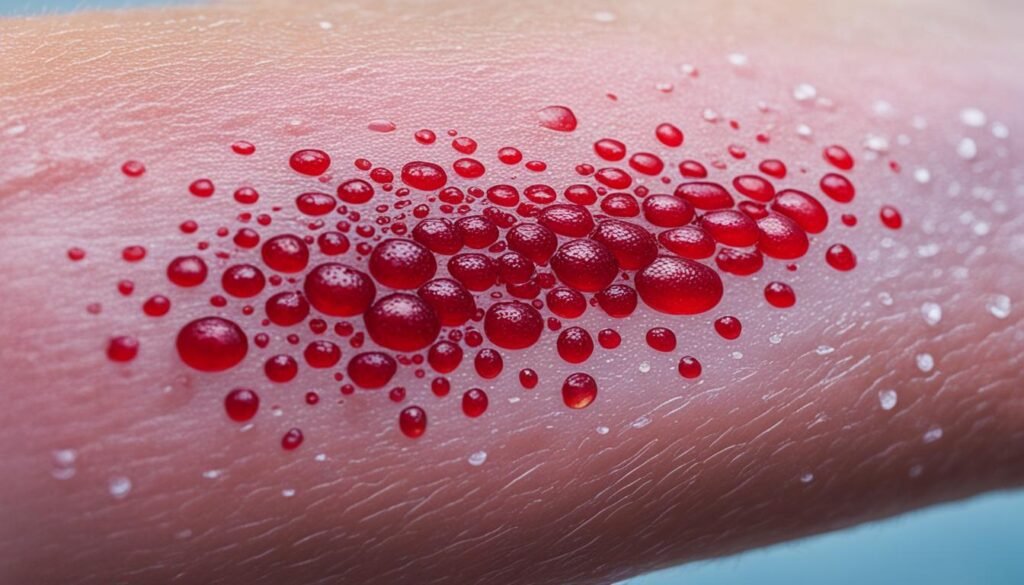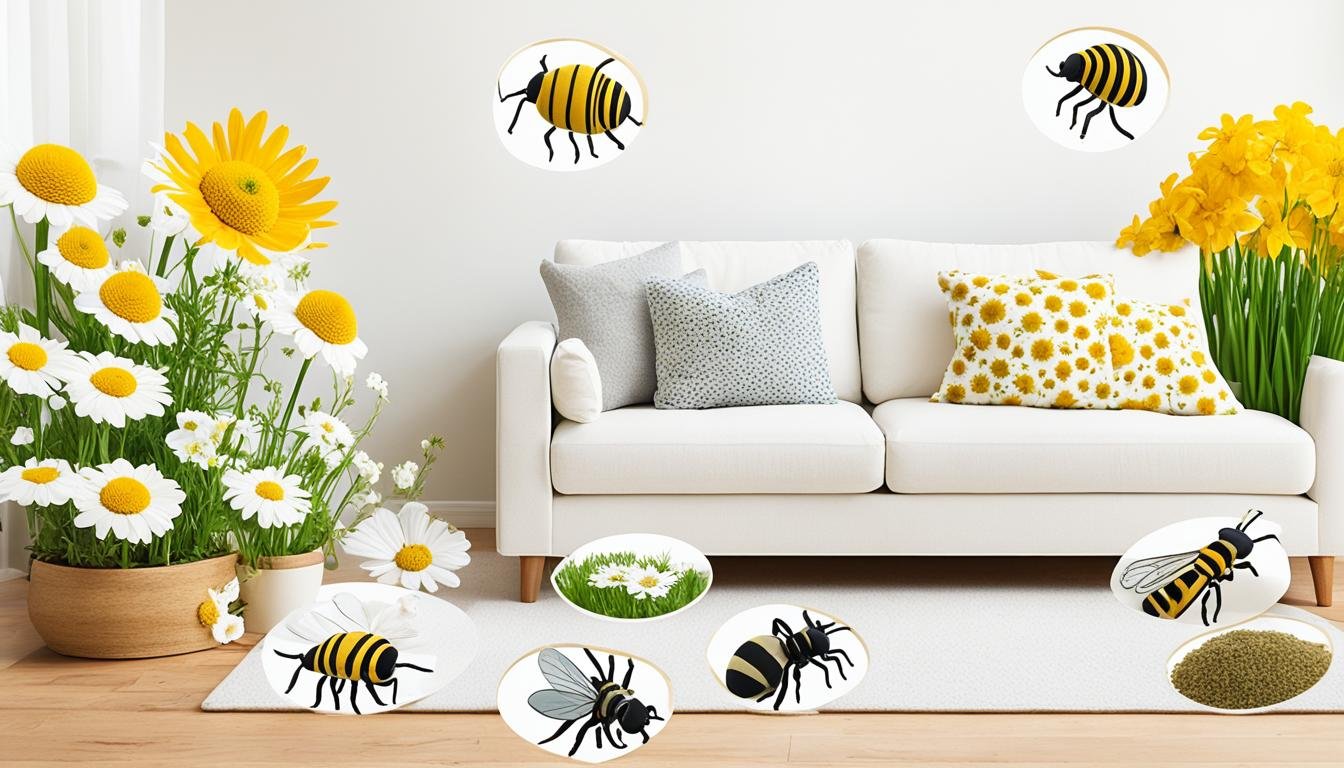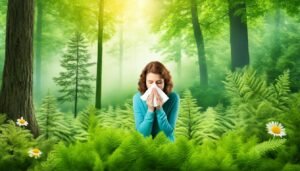Allergies are a big problem that many people face. They can cause a lot of discomfort. This article will talk about common allergy symptoms. It includes those from breathing issues, foods, bug stings, drugs, and skin problems. We’ll also look at the causes, how the body reacts, and common triggers.
When your body reacts to something that doesn’t bother most people, it’s an allergy.1 Things like certain pollens, animal fur, and some foods can be the culprits. Our immune system sees these items as harmful. It makes chemicals like histamine, which lead to the unpleasant allergy symptoms. Knowing how allergies happen helps in managing and treating them.
Key Takeaways
- Allergies can cause a range of uncomfortable symptoms, including respiratory, food, insect sting, medication, and skin reactions.
- Common allergens include pollen, pet dander, dust mites, certain foods, insect venom, and medications.
- The immune system’s response to allergens is the root cause of allergy symptoms.
- Recognizing allergy symptoms is the first step in effective management.
- Seeking medical advice is crucial for proper diagnosis and treatment of allergies.
Understanding Allergies
Allergies are widespread, impacting millions globally. They occur when the immune system overreacts to harmless substances.1 These are called allergens. The body then produces antibodies against these allergens. This process leads to allergy symptoms because the immune system sees the allergen as a threat. This response releases chemicals like histamine, causing sneezing and other allergic reactions.
What Causes Allergies?
Various allergens exist, ranging from pollen to foods and medications.1 When you come into contact with an allergen, it can cause different reactions. These can be as mild as a runny nose to as severe as anaphylaxis, a life-threatening condition.2 Knowing what causes allergies is key to managing them and minimizing risks.
Immune System Response to Allergens
Our immune system can mistake a harmless allergen for a threat. It then defends the body, triggering the release of histamine and other chemicals. This causes the allergy symptoms we know.1 Symptoms can vary from person to person. This depends on the allergen type, genetic makeup, and overall health.
Common Allergens
Pollen, pet dander, dust mites, and certain foods top the list of allergy triggers.1 Hay fever, caused by tree, grass, and weed pollens, is one example. Perennial allergies, like those to pet dander, can show year-round.1 Latex allergies can develop with more latex exposure.1
Respiratory Allergy Symptoms
Respiratory allergies bring many symptoms, mostly felt in the nose, eyes, and airways.3 Symptoms include a stuffy or runny nose, and sneezing. They happen when the body reacts to things like pollen, dust, and animal hair. This makes the body produce lots of mucus and cause swelling.3 Also, itchy, watery eyes are common.3 In asthma patients, it might cause wheezing and a tight chest, sometimes leading to shortness of breath.4
Nasal Congestion and Runny Nose
Frequent nasal congestion and a runny nose are key signs of respiratory allergies.3 They occur when the immune system overreacts to allergens. Excess mucus is produced, leading to a stuffed-up, runny nose.4 Effective treatments include nasal sprays. These can reduce the swelling and other allergy symptoms effectively.4
Sneezing and Itchy Eyes
Allergies commonly cause sneezing and itchy, watery eyes.3 The body’s reaction to allergens releases histamine and other chemicals. This irritates the nose and eyes, causing sneezing and an itchy eye sensation.3
Wheezing and Shortness of Breath
In some, allergies can lead to wheezing, chest tightness, and breathing problems, especially if they have asthma.4 Over 80% of asthma cases in children, and more than 50% in adults, are linked to allergens.4 For severe asthma worsened by allergies, treatments like Nucala and Dupixent are approved by the FDA.4
Food Allergy Symptoms
Food allergies can lead to various symptoms soon after eating the trigger food. Early signs often include a tingling or itching feeling in the mouth.5 This feeling might also pop up in the lips, tongue, or throat. These areas, along with the face, might start swelling as well.5 Often, hives, rashes, and other skin reactions may show up.5 In the worst cases, anaphylaxis can occur, which is life-threatening.
Tingling in the Mouth
A very common early symptom of a food allergy is a tingling or itching sensation in the mouth and throat.5 This happens soon after eating the allergenic food. It’s a sign that a serious reaction could follow.
Swelling of Lips, Tongue, and Throat
Another typical reaction is swelling in the lips, tongue, and throat.5 This swelling can be mild to severe. In the worst scenarios, it can make breathing hard, needing quick medical help.
Hives and Rashes
Skin issues like hives and rashes are quite common with food allergies.5 These can appear as red, itchy bumps or irritated skin areas. They often show up soon after eating the food that causes the allergy.

Insect Sting Allergy Symptoms
Allergic reactions to insect stings or bites are a serious concern. Swelling at the sting or bite area is common.6 Fire ants often leave a bump or hive that disappears in an hour. They can sting multiple times, leaving a pattern from both biting and stinging.
Hives and Itching
Developing hives and feeling intense itching are also frequent symptoms.6 To prevent stings, allergists advise not wearing sandals in grass. This is because honeybees and bumblebees are attracted to the white clover in lawns.
Breathing Difficulties
Sometimes, the immune system overreacts to stings, leading to breathing issues and chest tightness.7 Anaphylaxis is a severe, though rare, response that must be treated as an emergency.6 Immediate medical care is vital, often involving epinephrine, antihistamines, fluids, and oxygen.
7 Over 2 million Americans have venom allergies, making carrying two epinephrine kits wise.7 If you need epinephrine, it’s advised to have two emergency doses with you. This aids after an insect sting if you’re severely allergic.
6 Venom immunotherapy, under an allergist’s care, is very effective at preventing future reactions.6 By gradually increasing venom doses, it lowers sensitivity, matching the general population’s risk level.
6 Insect repellents don’t work well against stinging insects like fire ants and wasps.6 Instead, treating their mounds with special bait, containing soybean oil and corn grits mixed with chemicals, is effective.
6 Diagnostic tests for insect venom allergies include skin-prick, intradermal, and blood tests. These check for IgE antibodies to the specific insect venom.
Medication Allergy Symptoms
Allergic reactions to medicines can show up in many ways.8 You might get rashes, hives, or other skin issues.8
Your face may swell, including your lips and throat.8 This can make it hard to breathe and is very serious.
In rare cases, medicine allergies can cause wheezing, shortness of breath, and even anaphylaxis. This is a life-threatening reaction needing quick help.8
Rashes and Hives
Skin problems like rashes and hives are very common signs of medicine allergies.8 They make you itch and feel sore.
Facial Swelling
Medicine allergies can also make your face swell, especially the lips and throat.8 This is a big warning sign you need to see a doctor right away.
Wheezing and Anaphylaxis
8 Sometimes, medicines can cause worse reactions, like wheezing and anaphylaxis. Anaphylaxis can close your airways, make it hard to breathe, and lower your blood pressure suddenly.8 You need emergency care at once to avoid dangerous outcomes.
Skin Allergy Symptoms
Allergic reactions can show on the skin in many ways.9 Eczema and contact dermatitis are common signs. Eczema is a long-term skin issue, and contact dermatitis comes from touching an allergen. It can happen right after contact or a bit later.10 Eczema, or atopic dermatitis, affects 15 percent of kids. This number has almost doubled since 1997.9 These skin conditions make you itch, go red, and swell.9 With eczema, you might also see dry spots or clear fluid coming out. It’s often on your face, hands, or the bends in your arms and legs.
Itching and Redness
9 Allergic contact dermatitis can lead to a rash that hurts and itches. It might have raised bumps and blisters. This can happen right away or a couple of days after touching the allergen.11 Scenarios like this may last 2 to 4 weeks, even if you treat them.11 Using some skin medicines might actually make the problem worse.
Blisters and Rashes
10 Hives are raised, red bumps that show up on your skin. Acute hives don’t last more than six weeks. While chronic hives go on for more than six weeks.9 They might itch and hurt, which could be a sign of a serious allergy.11 There are more than 3,700 things that can cause skin rashes or swelling.11 Using certain products and then going out in the sun can lead to hives or rashes for some people.


10 Contact dermatitis can be because of irritants or allergens. It shows as a rash, blisters, or itchiness.9 It happens when your skin reacts to something it touches.11 Reactions to clothes, like materials or dyes, can show up a few hours to 10 days later. It’s not instant.
Anaphylaxis: A Severe Allergic Reaction
Anaphylaxis is a severe allergic reaction that can be life-threatening. It happens quickly after contact with allergens. These include foods, medications, insect stings, and latex.12
The symptoms might be shocking. They can include a drop in blood pressure, trouble breathing, throat and tongue swelling, and loss of consciousness.13 Immediate treatment is critical, usually with an epinephrine auto-injector.
Common triggers of anaphylaxis are certain foods, meds, insect venom, and latex.13 In adults, medicines often cause it. This might be from penicillin, other antibiotics, aspirin, or insulin.12 For kids, foods are often the cause. Common ones in the U.S. are peanuts, tree nuts, and more.12 Insects like bees and wasps can also trigger it, as well as latex.12
Anaphylaxis happens very quickly, sometimes within seconds.13 Symptoms can show up in minutes. But in some rare cases, they might take up to half an hour.13 Some people are more at risk, especially if they’ve had an anaphylactic shock before. Those with allergy, asthma, heart problems, or mastocytosis are also more likely to get it.13
Stopping anaphylaxis starts with avoiding triggers and having emergency medicine.13 Wearing a medical alert bracelet and staying away from known dangers is key.13 It’s wise for those at risk to have epinephrine with them always.12
Facing anaphylaxis means quick action is a must.13 Epinephrine is the best treatment for it, saving lives.12
Risk Factors for Allergies
There are several factors that can raise a person’s risk of getting allergies. If someone in your family has allergies, like hay fever or eczema, you might be more likely to get them too.2 Kids are also at a higher risk of allergies.2 Showing signs of allergy symptoms early, like asthma, makes you more prone to other allergies later.2
Family History
If your family has a history of asthma or allergies, your chances of getting allergies go up.2 This shows how much your genes can affect your body’s reaction to allergens.
Age
Most allergies start in childhood and continue into young adulthood. However, they can show up at any time in life.2 For example, about 8% of kids under 5 have food allergies, compared to 4% of adults.14
Existing Allergic Conditions
If you already have asthma or other allergies, you’re more likely to pick up new ones.2 Asthma and food allergies often happen together, increasing your troubles.14 Also, one allergy can pave the way for more – like getting eczema first, then possibly food allergies or other allergic reactions.15
Complications of Allergies
Allergies, if not managed well, can cause more health problems. They often lead to asthma or make it worse. This happens because things that people are allergic to can start asthma symptoms.2 They can also bring on sinus infections, and infections of the ears and lungs. These can really lower a person’s quality of life and health. So, managing allergies the right way is really important.
Asthma
Allergies can really make asthma symptoms worse. You might start wheezing, coughing, have a tight chest, or find it hard to breathe.2 All these happen because your airways get inflamed and narrow from allergens. This could lead to severe asthma attacks. It’s key to treat allergies well to stay on top of asthma and allergy symptoms.
Sinus Infections
Allergies can lead to sinus infections. This happens when the nose and sinuses get inflamed and make too much mucus.2 It’s a good place for germs to grow, causing pain, pressure, and fullness in the face. A person might also get headaches, have a fever, or find it hard to breathe through their nose.
Ear and Lung Infections
Allergies also raise the risk of ear and lung infections.2 Because of allergic reactions, the Eustachian tubes can get blocked. This then leads to ear infections. Allergies can also worsen lung infections like bronchitis or pneumonia. They do this by making the airways inflamed and irritated.
Allergy Symptoms in Children
Allergies in kids can mirror adult reactions but sometimes look different. Kids often get facial swelling, hives, and stomach issues when they face allergens.16 These problems can really affect their sleep and behavior, hurting their life quality.17 So it’s vital to spot and treat allergy symptoms early.
Children’s allergy symptoms may not be the same as adults’. They might show more facial swelling and hives. Gastrointestinal issues like nausea and vomiting are common too.16 These signs can disrupt a child’s sleep and behavior.17 Quick detection and care are necessary for their well-being.
Kids facing allergens may have severe effects like facial swelling and hives. They might also get a sick stomach.16 These reactions can seriously affect their daily life and health.17 It’s key to understand and manage their symptoms to protect their health.
| Allergy Symptoms in Children | Prevalence |
|---|---|
| Food Allergies | 16As many as 6 million children in the United States have some form of food allergy. |
| Common Food Allergy Triggers | 16The most common allergies in children are to peanuts and milk; other frequently seen triggers include eggs, fish, shellfish, soy, tree nuts, and wheat. |
| Severe Food Allergies | 16Severe reactions in children are typically to peanuts, tree nuts, fish, and shellfish, allergies that can last a lifetime. |
| Outgrown Food Allergies | 16Children often outgrow allergies to milk, eggs, soy, and wheat. |
| Anaphylaxis Risk | 16All parents of a child with a food allergy should be aware of the possibility of anaphylaxis, a potentially life-threatening reaction. |
| Epinephrine Prescriptions | 16Most children with food allergies are prescribed epinephrine (adrenaline) to use as soon as symptoms develop. |
| Allergies and Physical Activity | 16Having asthma does not mean eliminating physical education and sports; children with asthma should be able to participate in any sport, following doctor’s advice. |
| Allergies and School Environments | 16Children with allergic problems at school may need to sit away from the blackboard to avoid irritation from chalk dust. |
| Environmental Allergies | 17An estimated 7.1 million kids in the United States report environmental allergies. |
| Environmental Allergy Development | 17Children under two years of age are less likely to have environmental allergies as they need to be exposed to an allergen before developing an allergy. |
| Environmental Allergy Symptoms | 17Symptoms of seasonal allergies in children include a stuffy or runny nose, sneezing, itchy eyes and nose, sore throat, cough, and dark circles under the eyes. |
| Consequences of Allergies in Children | 17Allergies in children can lead to consequences like fatigue and poor concentration in school, increased ear and sinus infections, asthma exacerbations, and behavioral issues. |
| Allergy Treatment Options | 17There are safe and effective allergy medicines available over-the-counter for children, falling into categories such as oral antihistamines, nose sprays, and eye drops. |
| Nasal Spray Recommendations | 17Steroid nasal sprays are often recommended for children due to their known effectiveness and safety record in relieving nasal congestion from allergies. |
| Oral Antihistamine Considerations | 17Oral antihistamines for children vary in duration, effectiveness in alleviating itchiness, and side effects, with second-generation antihistamines causing less drowsiness and lasting longer compared to first-generation antihistamines. |
| Decongestant Concerns | 17Nasal or oral decongestants are generally avoided for children due to potential side effects like rebound runny nose and high blood pressure. |
| Topical Allergy Treatments | 17Topical treatments like allergy eye drops with antihistamines are more effective for itchy, swollen eyes in children compared to oral medication. |
| Long-Term Allergy Treatments | 17Long-term treatments such as immune therapy (allergy shots or sublingual/oral immunotherapy) can be considered, and parents should consult with a healthcare provider for exploring other medication options. |
Diagnosing Allergies
Finding out the cause of allergy symptoms is crucial for their treatment.18 Doctors ask for a detailed history of your signs and symptoms. They also do physical exams.18 Keeping a diary of when your symptoms happen can be very helpful. This can include notes on what you were doing or eating before the symptoms started.
Allergy tests like skin prick tests and blood tests can give incorrect results sometimes.18 So, it’s important to work closely with a healthcare provider to understand your results better.
Skin Prick Tests
19 Skin tests help find many common allergies and are more budget-friendly.19 They are quick too, showing sensitivities to allergens within about 15 minutes. If the skin reacts a lot, that might mean you’re likely allergic to it.19 But, a positive skin test doesn’t always mean you have an allergy or that it’s severe. And, a negative result might show no allergy is present.
Blood Tests
19 Blood tests are another way to check for allergies when skin tests won’t work. They look for specific IgE antibodies.18 But, they can also have issues with incorrect positive results. Sometimes, you’ll need to pause certain allergy medications before having these tests.
Elimination Diets
18 Food allergies may need detailed food diaries and taking out suspected foods for a while.18 Doctors may also ask about when symptoms start or get worse. They look into possible environmental causes and past treatments too.
18 Getting ready for an allergy visit means noting down your symptoms, family allergy past, and what medicines you’re taking.18 You’ll want to ask about any tests you need and the best treatments for your symptoms during the visit.
allergy symptoms
Learning what causes your allergies is important.1 It might mean writing down times and places you get symptoms. This can help see a pattern, so you know what activities or things around you start your allergies.1 Knowing when they happen and how bad they are helps your doctor create the right treatment for you.1
Identifying Triggers
Figuring out what starts your allergies is key. Things like pollen, pets’ fur, food, insect bites, or certain medicines are common triggers.2 By keeping track of your symptoms in a diary, you can find out what exactly sets them off. Then you can try to avoid these things or reduce how much you’re in contact with them.1
Tracking Symptoms
Paying close attention to when, how bad, and how long your allergies last is crucial. This info can really help your doctor make a plan that’s right for you.1 You should write down when the symptoms start, how bad they get, and if medication helps.1
Seeking Medical Advice
If your allergies are really bad or don’t go away, seeing a doctor is very important.1 Doctors can do tests to figure out what’s causing your allergies.2 Once they know, they can help you make a plan to deal with your allergies. This plan might include staying away from allergens, using medicine, or even getting allergy shots.2
Understanding your allergies, keeping track of your symptoms, and getting medical help is how you can fight back. It’s your way to lessen allergies’ effect on your life.12
Managing Allergies
Managing allergies well needs many steps. The first step is to stay away from things that make you react. Use air filters and clean your bed often. Try not to stay outside when pollen is thick.1
For staying away from allergy triggers, skip outdoor fun on windy days. Don’t do yard work that sends allergens into the air.20 Inside, use air conditioning and special filters to keep the air clean.20
Avoiding Allergens
To reduce exposure to allergy triggers, individuals can take steps such as avoiding outdoor activities on dry, windy days and refraining from lawn mowing or gardening chores that stir up allergens.20 Using air conditioning, high-efficiency filters, and dehumidifiers indoors can also help maintain cleaner air and reduce allergens.20
Medications and Treatments
When allergy symptoms start, medicines can help. Over-the-counter options include antihistamines, nasal sprays, decongestants, and saline rinses.20
For tougher allergies, doctors might suggest stronger medicines. There are also herbal remedies, acupuncture, and allergy shots. These can help a lot.20
Immunotherapy
Some people might benefit from immunotherapy. This means getting allergy shots over a long time to build tolerance.20 Or, you can use tablets under your tongue. This is another good option for fighting allergies.20
Tests can pinpoint what allergies bother you. This info helps in choosing the best treatment.20
Working with a healthcare provider is key to managing allergies. Together, you can figure out a plan that fits your needs. This might include avoiding allergens, taking medicines, or even getting allergy shots. Managing allergies in different ways can really improve your life.
Conclusion
Allergies bring a lot of discomfort and sometimes danger.14 About 8% of kids below 5 and up to 4% of adults have food allergies.21 In Germany, 1 out of 3 people develop an allergy in their life.22 Allergies are common, affecting about one-third of the population. They’re often seen in kids, causing issues like asthma and food allergies.
Learning the causes and signs of allergies is key. Allergy symptoms are often easy to spot. With the help of doctors, creating a good management plan is crucial. This way, people can manage their allergies and feel better. Finding and avoiding the things that trigger allergies is important. Proper medicines and sometimes a treatment called immunotherapy help a lot.22 Immunotherapy has the power to change how our immune system reacts to triggers, possibly curing allergies.
Allergies can really affect a person’s health and happiness. But, by being careful and getting the right treatments, life can be much better. It’s important to keep an eye out, visit doctors, and use the best treatments for you. This can lessen the troubles that come with allergies and lead to a happier life.
FAQ
What are the most common allergy symptoms?
What causes allergies?
How does the immune system respond to allergens?
What are some common respiratory allergy symptoms?
What are the symptoms of food allergies?
What are the symptoms of insect sting or bite allergies?
What are the symptoms of medication allergies?
What are the symptoms of skin allergies?
What is anaphylaxis?
What are some risk factors for developing allergies?
What are some common complications of allergies?
How are allergies diagnosed?
How can I identify and manage my allergy triggers?
What are the key components of effective allergy management?
Source Links
- https://my.clevelandclinic.org/health/diseases/8610-allergies
- https://www.mayoclinic.org/diseases-conditions/allergies/symptoms-causes/syc-20351497
- https://www.topdoctors.co.uk/medical-dictionary/respiratory-allergies
- https://www.verywellhealth.com/respiratory-allergies-symptoms-causes-and-treatment-5206183
- https://www.nhs.uk/conditions/food-allergy/
- https://acaai.org/allergies/allergic-conditions/insect-sting-allergies/
- https://www.webmd.com/allergies/insect-stings
- https://www.mayoclinic.org/diseases-conditions/drug-allergy/symptoms-causes/syc-20371835
- https://intermountainhealthcare.org/services/dermatology/conditions/skin-allergy/
- https://acaai.org/allergies/allergic-conditions/skin-allergy/
- https://www.webmd.com/allergies/skin-allergy-types-triggers
- https://aafa.org/allergies/allergy-symptoms/anaphylaxis-severe-allergic-reaction/
- https://www.mayoclinic.org/diseases-conditions/anaphylaxis/symptoms-causes/syc-20351468
- https://www.mayoclinic.org/diseases-conditions/food-allergy/symptoms-causes/syc-20355095
- https://www.verywellhealth.com/what-causes-allergies-8638245
- https://acaai.org/allergies/allergies-101/who-gets-allergies/children/
- https://www.chop.edu/news/health-tip/seasonal-allergies-keeping-symptoms-check
- https://www.mayoclinic.org/diseases-conditions/allergies/diagnosis-treatment/drc-20351503
- https://aafa.org/allergies/allergy-diagnosis/
- https://www.mayoclinic.org/diseases-conditions/hay-fever/in-depth/seasonal-allergies/art-20048343
- https://www.ncbi.nlm.nih.gov/books/NBK447112/
- https://www.frontiersin.org/articles/503052




